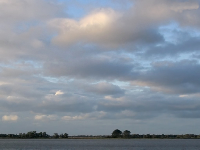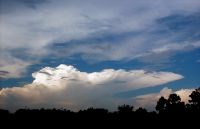Low Clouds
Clouds in this group:
- Stratus
- Nimbostratus
- Cumulus
- Stratocumulus
- Cumulonnimbus
Stratus clouds (St)
Stratus clouds at low altitudes generally create a flat layer with a fairly uniform base. Stratus cloud are featureless clouds varying in colour from dark gray to nearly white often making an even layer over the entire sky. These clouds do not usually bring precipitation, although if sufficiently low in altitude to become fog, drizzle or mist may result.
Nimbostratus Cloud (Ns)
Nimbostratus is a gray, often dark, cloud layer whose apperance is usually rendered diffuseby falling rain or snow. Nimbostratus clouds usually cover the entire sky and is thick enough to blot out the sun. Ragged clouds or shreds called scuds, frequently occur below the main layer, indicating immenent wind and precipitation. The precipitation produced by these clouds is steady and presistent.
Cumulus (Cu)
Fair-weather, or cumulus, clouds are detached from one another and generally have well-defined, flat bases and domed tops resembling cauliflower. Their outlines are sharp, and they often develop vertically in the form of rising mounds, domes, or towers. The sunlit parts are brilliant white, the base is relatively dark and rough horizontal.
Stratocumulus (Sc)
Clouds that form in low,distinct, gray or whitish patches are called stratocumulus. The patches have a well defined, rounded appearance and ar often organized into rounded masses, rolls, or regular long sheets. Their flat, even bases have dark patches and a checkeboard pattern, while their tops are rounded. Frequently, these clouds are arranged in bands , or rolls, lying across the wind, indicating the wind's direction at cloud height.
Cumulonimbus (Cb)
Forming heavy, dense columns, Cumulonimbus clouds rise from low altitude to great heights. Upon reaching the upper inversionat the tropopause level, their topmost portion spreads out in an anvil shape. Dark bases and the white or gray anvil tops of cumulonimbus clouds are a sure sign of severe weather. Precipitation in the form of rain or hail can be heavy.





